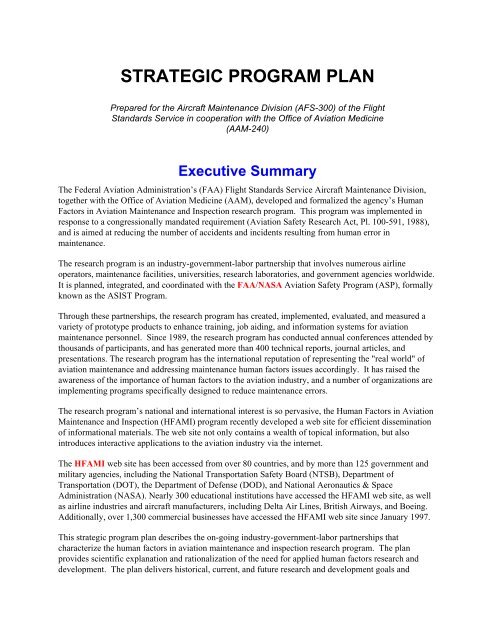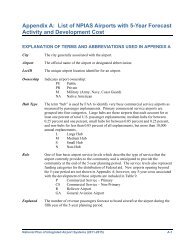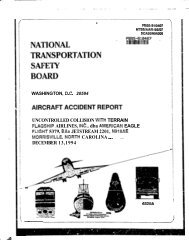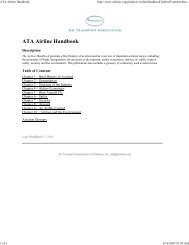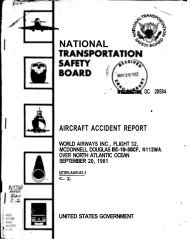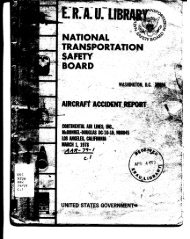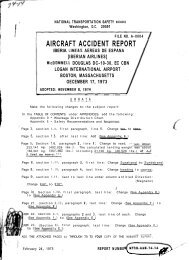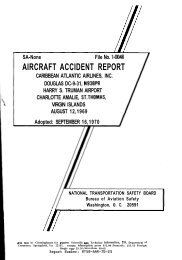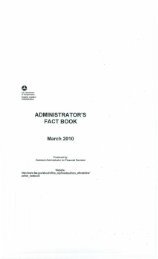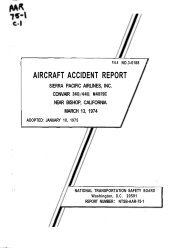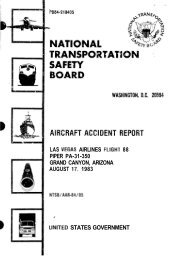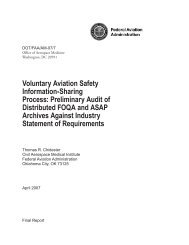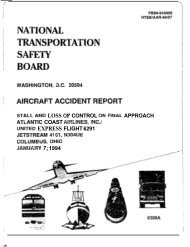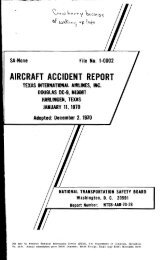Strategic program plan
Strategic program plan
Strategic program plan
Create successful ePaper yourself
Turn your PDF publications into a flip-book with our unique Google optimized e-Paper software.
STRATEGIC PROGRAM PLAN<br />
Prepared for the Aircraft Maintenance Division (AFS-300) of the Flight<br />
Standards Service in cooperation with the Office of Aviation Medicine<br />
(AAM-240)<br />
Executive Summary<br />
The Federal Aviation Administration’s (FAA) Flight Standards Service Aircraft Maintenance Division,<br />
together with the Office of Aviation Medicine (AAM), developed and formalized the agency’s Human<br />
Factors in Aviation Maintenance and Inspection research <strong>program</strong>. This <strong>program</strong> was implemented in<br />
response to a congressionally mandated requirement (Aviation Safety Research Act, Pl. 100-591, 1988),<br />
and is aimed at reducing the number of accidents and incidents resulting from human error in<br />
maintenance.<br />
The research <strong>program</strong> is an industry-government-labor partnership that involves numerous airline<br />
operators, maintenance facilities, universities, research laboratories, and government agencies worldwide.<br />
It is <strong>plan</strong>ned, integrated, and coordinated with the FAA/NASA Aviation Safety Program (ASP), formally<br />
known as the ASIST Program.<br />
Through these partnerships, the research <strong>program</strong> has created, implemented, evaluated, and measured a<br />
variety of prototype products to enhance training, job aiding, and information systems for aviation<br />
maintenance personnel. Since 1989, the research <strong>program</strong> has conducted annual conferences attended by<br />
thousands of participants, and has generated more than 400 technical reports, journal articles, and<br />
presentations. The research <strong>program</strong> has the international reputation of representing the "real world" of<br />
aviation maintenance and addressing maintenance human factors issues accordingly. It has raised the<br />
awareness of the importance of human factors to the aviation industry, and a number of organizations are<br />
implementing <strong>program</strong>s specifically designed to reduce maintenance errors.<br />
The research <strong>program</strong>’s national and international interest is so pervasive, the Human Factors in Aviation<br />
Maintenance and Inspection (HFAMI) <strong>program</strong> recently developed a web site for efficient dissemination<br />
of informational materials. The web site not only contains a wealth of topical information, but also<br />
introduces interactive applications to the aviation industry via the internet.<br />
The HFAMI web site has been accessed from over 80 countries, and by more than 125 government and<br />
military agencies, including the National Transportation Safety Board (NTSB), Department of<br />
Transportation (DOT), the Department of Defense (DOD), and National Aeronautics & Space<br />
Administration (NASA). Nearly 300 educational institutions have accessed the HFAMI web site, as well<br />
as airline industries and aircraft manufacturers, including Delta Air Lines, British Airways, and Boeing.<br />
Additionally, over 1,300 commercial businesses have accessed the HFAMI web site since January 1997.<br />
This strategic <strong>program</strong> <strong>plan</strong> describes the on-going industry-government-labor partnerships that<br />
characterize the human factors in aviation maintenance and inspection research <strong>program</strong>. The <strong>plan</strong><br />
provides scientific ex<strong>plan</strong>ation and rationalization of the need for applied human factors research and<br />
development. The <strong>plan</strong> delivers historical, current, and future research and development goals and
applied deliverables. Under continuing association with the aviation industry worldwide, the research<br />
<strong>program</strong> ensures that human performance is a central focal point of the aviation maintenance system.<br />
The goal of the Human Factors in Aviation Maintenance and Inspection research <strong>program</strong> is to achieve<br />
significant reduction of aircraft maintenance accidents and incidents caused by human factors. Without<br />
such effort, the limitations of human performance will continue to be taxed by an increasingly demanding<br />
environment.<br />
Program Mission Statement<br />
To pursue applied research in human-centered aircraft maintenance and inspection safety issues and to<br />
develop products that provide applied practical solutions responsive to requirements from industry, labor,<br />
research, and regulatory agencies.<br />
Goals<br />
• Reduce aircraft maintenance and ground operation accidents, incidents, and related errors.<br />
• Direct and coordinate industry and regulatory efforts nationally and internationally.<br />
• Improve effectiveness and efficiency of the aviation maintenance and FAA Aviation Safety Inspector<br />
workforce.<br />
• Maintenance Resource Management<br />
• Maintenance Error Reduction<br />
Primary Activities<br />
• Job Task Analysis in Aviation Maintenance Environments<br />
• Maintenance and Inspection Training<br />
• Job Aids for Maintenance and Inspection<br />
• Information Dissemination<br />
• Communication and Harmonization<br />
Introduction<br />
Aircraft maintenance human factors is one of the last "frontiers" that can have significant impact on<br />
aviation safety. This introduction first explains why there is a growing requirement for applied research
in human factors for the aviation maintenance community. The section then defines human factors and<br />
how it can improve safety for the aviation maintenance community.<br />
Growing Requirement for Maintenance Human Factors<br />
Research<br />
Accidents and incidents are more likely to be caused by the actions of humans than by mechanical failure.<br />
Industry statistics show that human error contributes to nearly 80% of airline accidents and incidents, as<br />
illustrated below. This figure includes all aspects of human factors including operations, maintenance, and<br />
air traffic control. Because aviation systems are continually improving, the aircraft is seldom the cause of<br />
an accident and incident. Humans, rather than equipment, are more likely to be at the root cause of an<br />
accident or incident. Therefore, the best opportunity for safety improvement is to understand and manage<br />
the human factors that pose safety risks.<br />
Aircraft maintenance human factors research is particularly critical for improving aviation safety. Table 1<br />
is a partial list of airline accidents where the probable cause is maintenance related (see Appendix A for a<br />
complete listing). In each of these cases, a mechanical failure was not the true culprit, but rather some<br />
aspect of the maintenance organization related to human performance was a casual factor of the accident.
One example from Table 1 is an incident involving a "dragged engine on rollout" of a Northwest B-747<br />
at the Tokyo Narita Airport in March 1994. The front of an engine fell from its mount causing its nose<br />
cowl to drag along the runway. The friction caused a small fire, which was extinguished by a ground<br />
crew. There were no injuries. The NTSB investigation showed a variety of maintenance actions that<br />
contributed to the incident, many of which were rooted in human factors.<br />
The factors included the following:<br />
• inadequate training for the specific engine maintenance and inspection task<br />
• poor tracking of maintenance responsibility<br />
• inadequate lighting in the maintenance workplace<br />
• improper use of job card instructions<br />
• work environment conducive to error<br />
• FAA inspectors failing to apply FAA-developed human factors guidelines for adequate work<br />
environments<br />
There is good evidence to project that such accidents can be expected to continue to occur. Figure 2<br />
shows that maintenance costs, passenger miles flown, and the number of aircraft have all exceeded the<br />
overall growth of the aviation maintenance technician (AMT) workforce (Air Transport Association,<br />
1996) by substantial percentages. The obvious conclusion is that the AMT must raise efficiency to match
the increasing work load.<br />
The proportionately smaller workforce is also faced with other factors which compound the workload<br />
problem. Advanced technology aircraft with sophisticated composite structures, computers, and avionics<br />
add to the skills and knowledge required to perform maintenance today. In addition, aging fleets require<br />
increased labor efforts to keep older aircraft flying safely.<br />
To meet these challenges without sacrificing safety, individual technician responsibilities and skill levels<br />
must increase. The industry must work together to ensure that workers become more qualified and that<br />
maintenance tasks and procedures are adapted to meet human capability. Attention to human factors in<br />
aircraft maintenance will ensure not only continuing performance enhancement of the technician<br />
workforce, but also continuing flight safety.<br />
This strategic <strong>program</strong> <strong>plan</strong> details how the Aircraft Maintenance Division of Flight Standards Service<br />
(AFS-300) is responding to safety and human performance challenges via the Human Factors in Aviation<br />
Maintenance and Inspection research <strong>program</strong>.<br />
How Human Factors Research Can Help<br />
"Human Factors" refers to the study of human capabilities and limitations in the workplace. Human
factors include, but are not limited to, such attributes as human physiology, psychology, work place<br />
design, environmental conditions, human-machine interface, and more. Human factors researchers study<br />
system performance. That is, they study the interaction of humans, the equipment they use, the written<br />
and verbal procedures and rules they follow, and the environmental conditions of any system.<br />
Figure 3 illustrates the maintenance system, where the system starts with an aircraft ready for inspection<br />
and repair. Maintenance personnel, using tools and procedures within the maintenance environment,<br />
must maintain the aircraft. Figure 3 indicates four human factors that affect the human maintainer:<br />
training, job aiding, information systems, and error reduction practices. When the system is optimized, the<br />
result is an aircraft ready for dependable and safe use, such that the costs are affordable to travelers and<br />
the operation is profitable to the airline. As Figure 3 illustrates, in a complex system there are multiple<br />
approaches to optimizing system performance. The research <strong>program</strong> has identified seven primary<br />
research activities that address different aspects of the maintenance system:<br />
• Maintenance Resource Management<br />
• Maintenance Error Reduction<br />
• Job Task Analysis in Aviation Maintenance Environments<br />
• Maintenance and Inspection Training<br />
• Job Aids for Maintenance and Inspection<br />
• Information Dissemination
• Communication and Harmonization<br />
Maintenance Resource Management<br />
Maintenance Resource Management (MRM) has become an umbrella term that has yet to be clearly<br />
defined. Some current MRM <strong>program</strong>s may parallel the Crew Resource Management (CRM) <strong>program</strong>s<br />
used for improving team communication and performance in the cockpit. By defining resource<br />
management for maintenance and investigating related issues, this research will develop guidelines and<br />
related training and reference materials for MRM through extensive cooperation with the airline industry.<br />
Maintenance Error Reduction<br />
Error reduction is a key activity for the research <strong>program</strong>. The <strong>program</strong> seeks to develop methodologies<br />
or techniques to proactively minimize aircraft maintenance errors and enhance safety. General areas for<br />
research include error classification, identification, mitigation, and reduction.<br />
Job Task Analysis<br />
Job Task Analysis (JTA) is a technique used to determine the necessary knowledge, skills, and abilities<br />
required to perform the various tasks of a specified job. Job Task Analysis data is then used as the basis<br />
for developing curriculum.<br />
A JTA is being conducted to gain an understanding of the current tasks that Aviation Maintenance<br />
Technicians perform. This project is an on-going grant that has been supervised by the FAA Technical<br />
Center through June 1997. The research project has cooperated with all sectors of the aviation<br />
maintenance community to update and upgrade the training standards for technicians performing<br />
maintenance in the current and future environment.<br />
Maintenance and Inspection Training<br />
Research activities in this category include studies for the improvement of maintenance training<br />
curriculum, delivery systems, and investigation of new technology for improved training methods. All<br />
prototype training products shall be pragmatic and aimed at affecting a measurable change in human<br />
performance in aviation maintenance and inspection. Related studies, such as investigations of personnel<br />
selection methods and workforce projections, are also included in this category.<br />
Job Aids for Maintenance and Inspection<br />
Job Aiding research acknowledges the requirements, capabilities, and limitations of human maintenance<br />
personnel. The research <strong>program</strong> identifies areas where human performance can benefit from improved or<br />
new support tools. The <strong>program</strong> develops prototype tools that support AMT performance. In addition,<br />
the <strong>program</strong> evaluates the feasibility and effectiveness of job aiding techniques and technologies, thereby<br />
improving safety through improved task performance.
Information Dissemination<br />
Human factors research can only have an impact if the results and products of the research <strong>program</strong> are<br />
disseminated to the aviation maintenance community. The research <strong>program</strong> develops and distributes<br />
technical and scientific documentation via the FAA Human Factors Guide for Aviation Maintenance and<br />
Inspection and various research reports. Software prototypes for training or job aiding are provided to the<br />
industry via the internet and CD-ROMs.<br />
Communication and Harmonization<br />
Aviation safety is an international activity. For that reason the research <strong>program</strong> cooperates with a variety<br />
of international organizations, governments, and airlines. Examples of cooperative efforts include the<br />
joint working agreement among the Federal Aviation Administration (FAA), the Civil Aviation Authority<br />
(CAA) in the United Kingdom, and Transport Canada. Further, the research, engineering, and<br />
development team is active with the International Civil Aviation Organization (ICAO), International Air<br />
Transport Association (IATA), Air Transport Association (ATA), National Air Transport Association<br />
(NATA), and a variety of U.S. and international carriers. The work of the research <strong>program</strong> is presented<br />
at international conferences and showcased at annual conferences sponsored by the research <strong>program</strong>. In<br />
addition, the <strong>program</strong> supports harmonization of regulatory and guidance material with international<br />
bodies.<br />
Background<br />
Under sponsorship from the FAA Flight Standards Service, the FAA Office of Aviation Medicine has<br />
created a successful research <strong>program</strong> to investigate applied issues in human factors in aviation<br />
maintenance and inspection. This section reviews the formation of the research <strong>program</strong> and describes its<br />
basic structure for fulfilling its mission and goals, as listed in this strategic <strong>program</strong> <strong>plan</strong>. The section<br />
concludes with a discussion of <strong>program</strong> funding levels and the requirements for increased funding.<br />
Formation of the Program<br />
Responding to industry concerns, the Aircraft Maintenance Division of the Flight Standards Service,<br />
initiated human factors-related research beginning in 1987. A year later, the Aviation Safety Research<br />
Act of 1988 mandated research "…to develop a better understanding of the relationship between human<br />
factors and aviation accidents and between human factors and air safety…" The Aloha Airlines accident<br />
also occurred in 1988, prompting increased congressional and public concerns resulting with increased<br />
research funding. By 1989, the <strong>program</strong> was formalized with the formation of the FAA Scientific Task<br />
Planning Group (STPG). The STPG provided direct maintenance industry <strong>plan</strong>ning and involvement<br />
with the <strong>program</strong>. The National Plan for Civil Aviation Human Factors was developed in 1990 and<br />
formed a core foundation for the research <strong>program</strong>. The National Plan has been a major influence driving<br />
the maintenance human factors research and development <strong>program</strong> during the nineties.
Overview of the Research and Development Process<br />
The research <strong>program</strong> interacts with many national and international groups to provide timely and needed<br />
research products. Figure 4 illustrates the overall process by which requirements are turned into products.<br />
Note that the research <strong>program</strong> is responsive to both government and industry requirements. Government<br />
requirements come from within the FAA (G-7 and Aviation Rule Making Advisory Committees<br />
[ARACs]) and from other governmental organizations, such as the National Transportation Safety Board<br />
(NTSB), the Department of Transportation (DOT/FAA Aviation Safety Action Plan - Zero Accidents…A<br />
Shared Responsibility), the White House (Commission on Aviation Safety and Security), the Joint<br />
Aviation Authority (JAA), and the International Civil Aviation Organization (ICAO). Industry<br />
requirements come from organizations such as the Air Transport Association (ATA) and its committees<br />
(e.g., Human Factors, Maintenance Training, Engineering and Maintenance, and Technical Information<br />
Communications Committee) as well as the Aviation Technician Education Council (ATEC),<br />
Professional Aviation Maintenance Association (PAMA), the International Air Transport Association<br />
(IATA) and the aviation groups of the Society of Automotive Engineers (SAE). In addition, the<br />
International Association of Machinists and Aerospace Workers (IAM & AW) has been a very active<br />
party in many of the research activities. After internal review and requirement prioritization, research is<br />
then executed via university grants, <strong>program</strong> contracts, and other vehicles.
A field laboratory approach is used to complete research tasks, emphasizing on-site observation,<br />
measurement and testing at airline maintenance facilities. The products developed and evaluated by the<br />
research <strong>program</strong> include data to support regulatory efforts, Advisory Circulars and informal guidance<br />
material, prototype job aids and training systems. These products are communicated to industry, the<br />
military, and others via conferences and publications. The FAA human factors <strong>program</strong> distributes all of<br />
its research reports and software deliverables to industry via CD-ROMs and the internet. Table 2<br />
summarizes the widely distributed <strong>program</strong> products.<br />
Finally, the R, E&D process relies on a feedback loop, shown in Figure 4. Field evaluations of products<br />
and techniques provide feedback that is used to guide future work as well as information on the<br />
usefulness of products. In addition, the <strong>program</strong> seeks feedback from industry on completed research.<br />
Such feedback provides additional or adjusted requirements for future research.<br />
Program Funding<br />
Funding for the Human Factors in Aviation Maintenance and Inspection research <strong>program</strong> has<br />
traditionally been at relatively low levels, when compared to flight deck human factors. The pie chart in
Figure 5 shows that in FY 1997, aircraft maintenance research received 12% of the funding at a total of<br />
$1.265 M. In 1998 the $1.3M funding is a reduction representing 10% of the budget.<br />
The White House, NTSB, and DOT all agree that the time has come for maintenance human factors to<br />
receive additional funding to address important safety concerns. In 1995, the DOT/FAA Aviation Safety<br />
Action Plan (Zero Accidents…A Shared Responsibility) recommended that the Flight Standards Service<br />
devote additional research effort towards human factors for aircraft maintenance, focused on error<br />
detection and prevention. The 1997 White House Commission on Aviation Safety and Security Report<br />
identified numerous opportunities to improve airline safety, among them, extending the areas of FAA<br />
current human factors research. The research <strong>program</strong> needs appropriate funding to respond to the<br />
increasing requirements for aircraft maintenance human factors research.<br />
Summary of Past Accomplishments<br />
In order to understand where the research <strong>program</strong> is going, it is important to understand what the<br />
<strong>program</strong> has accomplished to date. The research <strong>program</strong> is embraced nationally and internationally by<br />
the FAA, industry, academia, and the human factors scientific community at large. The research team<br />
members have helped airlines implement and evaluate training for maintenance resource management and<br />
have assisted the ATA Maintenance Training Committee to "raise the bar" regarding requirements for<br />
advanced technology training. The FAA Human Factors Guide for Aviation Maintenance, developed by<br />
the research <strong>program</strong>, is recognized by industry maintenance personnel, other government industries, and<br />
military throughout the country and the world. The FAA Flight Standards Service has fielded the On-line<br />
Aviation Safety Inspection System (OASIS), which is a mobile computing job aid for the Flight<br />
Standards Service Aviation Safety Inspectors. These and other research products have made the<br />
transition, with overwhelming success, from the research <strong>program</strong> into government and industry.<br />
This section highlights some of the key products that the research <strong>program</strong> has delivered. These products<br />
are organized by the primary activities of the research <strong>program</strong>. All of the research <strong>program</strong>’s products,<br />
procedures, and reports contribute to continuing safety and improvement of operational efficiency
through improvements in human performance.<br />
Job Task Analysis Products<br />
Job Task Analysis projects can be broad or narrow in focus. The research <strong>program</strong> has conducted JTAs<br />
of both types.<br />
AMT JTA<br />
Regulatory efforts to revise the FAA airframe and power<strong>plan</strong>t mechanic certificate have led to the<br />
development of a proposed Part 66 rule. This rule prescribes new training and certification standards for<br />
technicians returning transport aircraft to service (Parts 25/29). Those who complete this training would<br />
receive the Aviation Maintenance Technician (Transport) AMT-T certification. The change in the<br />
certificate structure implies that corresponding training requirements will be needed. The JTA supported<br />
the regulatory effort by collecting survey data on tasks performed by AMTs across all segments of civil<br />
aviation. A total of 2,434 validated surveys were collected from 84 facilities. Respondents rated 303<br />
tasks in 20 subject areas in three categories: frequency, criticality and difficulty to learn. The JTA results<br />
provide data to support the regulatory changes and provide an objective basis for AMT-T curriculum<br />
development.
Supervisory JTA<br />
Airlines indicated that maintenance personnel receive a lot of technical training, but supervisory positions<br />
within maintenance have not been systematically studied. A Job Task Analysis was conducted that<br />
focused on analyzing the tasks of first and second level aircraft maintenance supervisors (foremen and<br />
lead mechanics). A detailed listing of tasks was created for three broad categories of supervisory tasks:<br />
Administrative, Operational, and Personnel. This JTA identified the need for improved training for new<br />
foremen and lead mechanics. A preliminary curriculum outline for leadership training was also developed<br />
in conjunction with two airline partners over a six-month period.<br />
Maintenance Resource Management Products<br />
Maintenance Resource Management is a relatively new focus area for the <strong>program</strong>. The first major<br />
product was the prototype Team Situation Awareness Training Curriculum.<br />
Team Situation Awareness (SA) Training Curriculum<br />
Airlines have requested expertise related to situation awareness in maintenance. The research team<br />
responded with a prototype training curriculum. The objective of this curriculum is to equip Technical<br />
Operations personnel with the skills and abilities to develop an awareness and understanding of factors<br />
that affect SA in the maintenance domain and team processes. Five SA concepts are taught: 1) Shared<br />
Mental Model, 2) Verbalization of Decision, 3) Better Shift Meetings and Teamwork, 4) Feedback, 5) SA<br />
Errors. Materials include Microsoft Power Point slides, group activities, and a facilitator’s handbook.<br />
The SA Training Curriculum shall be included on FAA CD-ROM ‘98, which has been published
annually since 1993.<br />
Training Products<br />
Completed prototype training products include the Environmental Control System Tutor, the Team<br />
Situation Awareness Training Curriculum, the System for Training Aviation Regulations and the Aircraft<br />
Maintenance Team Training Program. These systems use a combination of instructional methods for<br />
training delivery. The training research answers industry’s request for demonstrations of advanced<br />
technology for training maintenance technicians.<br />
Environmental Control System Tutor (ECS)<br />
The ECS Tutor uses intelligent simulation for maintenance training. It simulates the operation of the<br />
ECS for the B-767-300. As the student operates and troubleshoots the system, the simulation maintains<br />
models for student, instructor, and expert knowledge. These models allow the ECS Tutor to provide<br />
remediation and advice to the student. ECS was included on FAA CD ‘94.<br />
System for Training Aviation Regulations (STAR)<br />
Aviation maintenance trainers lament the "boring" task of training FAA regulations using conventional<br />
instructional methods. STAR-AMT provides Part 147 school instructors with a computer-based tool to
help convey the role the Federal Aviation Regulations (FARs) play in the daily operations of aviation<br />
maintenance. The system is heavily infused with multimedia to motivate student interest. Scenario-based<br />
training techniques are employed to place students in true-to-life work scenarios where FAR-dependent<br />
decisions need to be made. STAR-AMT has several different learning environments: Overviews,<br />
Scenarios, Challenges, and Resources. STAR-AMT is included on FAA CD ‘97.<br />
FAA has also expressed a requirement to deliver on-the-job computer-based training for Aviation Safety<br />
Inspectors (ASI). The purpose of STAR-ASI is to be an on-the-job training aid for Aviation Safety<br />
Inspectors. It is designed to function as both a training tool for new inspectors and a reference resource<br />
for seasoned inspectors. Like STAR-AMT, STAR-ASI has Scenarios, Challenge Questions, a Glossary<br />
and a Document Browser. In place of the Overview learning environment, STAR-ASI has the Inspection<br />
Task Flow Chart learning environment. STAR-ASI is included on FAA CD ‘97.
Aircraft Maintenance Team Training<br />
This tool is a multimedia computer-based team training <strong>program</strong> that trains aircraft maintenance<br />
technicians (AMTs) on team skills that are critical in performing aircraft maintenance tasks. The goals of<br />
the software are: to provide AMTs a systematic exposure to a teamwork skills curriculum, to allow users<br />
to learn at their own pace, to monitor the progress of users in acquiring team skills, and to motivate the<br />
users to learn and use the skills through an interesting, media-rich and interactive environment. Aircraft<br />
Maintenance Team Training was published on a stand-alone CD in 1997.
Job Aiding Products<br />
The next group of products is the job aiding products. These products include the Performance<br />
Enhancement System Program which evolved into the On-line Aviation Safety Inspection System<br />
(OASIS), the Ergonomics Audit Program, the Coordinating Agency for Supplier Evaluation Job Aid, the<br />
Documentation Design Aid, and the Turbine Repair Automated Control System. These products<br />
capitalize on advanced technology information systems.<br />
Performance Enhancement System (PENS) Program & OASIS<br />
The Performance Enhancement System is an electronic performance support system designed for FAA<br />
Aviation Safety Inspectors. It provides data entry and validation support, as well as on-line access to<br />
policy guidance such as Federal Aviation Regulations, Airworthiness Directives, and Inspector's<br />
Handbooks. This system has evolved into the On-line Aviation Safety Inspection System (OASIS),<br />
which is currently being used by the FAA Flight Standards Service. This effort is an excellent product of<br />
a research, engineering, and development project running the gamut from conceptualization to full scale<br />
development for all FAA Aviation Safety Inspectors worldwide. The PENS prototype was included on
FAA CD ‘94.<br />
Ergonomics Audit Program (ERNAP)<br />
Industry personnel requested a job aid that would permit them to conduct human factors audits without<br />
retaining a human factors consultant. ERNAP is a computerized job aid to help managers evaluate or<br />
design ergonomically efficient procedures for maintenance and inspection. ERNAP is simple to use and<br />
evaluates existing and proposed tasks and setups by applying ergonomic principles. ERNAP also suggests<br />
ergonomic interventions based on its evaluation. ERNAP allows the auditor to maintain audits for further<br />
reference. ERNAP was included on FAA CD ‘96.
Coordinating Agency for Supplier Evaluation (CASE) Job Aid<br />
Airlines and suppliers asked for an electronic checklist tool for collecting supplier evaluation data. The<br />
CASE Vendor Audit <strong>program</strong> contains electronic CASE forms for auditing suppliers such as fuel<br />
vendors. These checklists are integrated with standards and regulation references to enable quick<br />
look-ups. The CASE Vendor Audit <strong>program</strong> also includes a facility for saving/retrieving audits and a<br />
report generation module for printing the results and findings of the audit based on the completed<br />
checklist. CASE was included on FAA CD ‘96.
Documentation Design Aid (DDA)<br />
Airline documentation writers asked for help to ensure that their procedures use Simplified English and<br />
follow proper human factors conventions. Two versions of the DDA were developed to improve the<br />
ability of technical writers and engineers to write more usable documents. The paper-based version lists<br />
the rules in a format suited to the user’s needs. A computer-based version adds reasons for the rules and<br />
examples of their use. Both versions were similarly effective in allowing users to find and make changes<br />
in existing aircraft maintenance task documentation. The DDA shall be included on FAA CD ‘98.
Turbine Repair Automated Control System (TRACS)<br />
Industry expressed the requirement to have easy access to manufacturers and regulatory information.<br />
TRACS is an integrated software tool which aids airline technicians in tracking, repairing, and returning<br />
jet engine parts back to serviceability. The prototype system gives technicians and inspectors the ability<br />
to log critical information and data, access manuals and orders, and sign-off on repair steps in the shop<br />
environment. The operational TRACS is included on FAA CD ‘97.
Information Dissemination Products<br />
The research <strong>program</strong> disseminates reference materials on human factors information to the aviation<br />
maintenance community at large. These reference materials can be used by people throughout the<br />
maintenance organization.<br />
Human Factors Guide<br />
Industry participants involved with the FAA Human Factors in Aviation Maintenance research <strong>program</strong><br />
requested practical human factors guidance that could be used on the shop floor. In addition,<br />
maintenance managers requested information that could be used to make informed decisions with respect<br />
to human factors issues in aviation maintenance, including pointers on where to find additional<br />
information or help. The Human Factors Guide for Aviation Maintenance was first completed and<br />
published in 1995. Three additional chapters were added in 1996 to make fifteen in all (see Figure 8).<br />
The Guide is designed to be used in aviation maintenance environments and is written for maintenance<br />
management. However, it contains information and guidance that can be used by people with various<br />
responsibilities within maintenance organizations. The Guide is available in hardcopy, on CD-ROM, and<br />
on the internet at http://www.hfskyway.com.
HFAMI Web Site<br />
The Human Factors in Aviation Maintenance and Inspection (HFAMI) Web site is an on-line information<br />
exchange for the Human Factors in Aviation Maintenance Research Program. It includes an interactive<br />
forum for human factors professionals as well as a repository for electronic and multimedia reference<br />
documents and <strong>program</strong>s. The HFAMI web site has been accessed over 1 million times since January<br />
1997.
Hypermedia Information System (HIS)<br />
Government, industry, and academic personnel have requested a means for easy access and search of all<br />
of the research results. Thus the Hypermedia Information System was developed. HIS is an electronic<br />
reference of over 4,000 pages of publications from the Human Factors in Aviation Maintenance research<br />
<strong>program</strong>, including phase reports and conference proceedings. HIS makes it easy to find information<br />
about specific topics with its hypermedia links and fast, full-text search engine. HIS is updated annually<br />
on the FAA Human Factors Issues in Aircraft Maintenance and Inspection CD-ROMs.
Communication and Harmonization Products<br />
Annual conferences have been the standard forum for providing communication of research results and<br />
industry needs. Eleven Human Factors Issues in Maintenance and Inspection conferences have been<br />
conducted, as listed in Table 3.
1997 Activities<br />
This section details the 1997 activities of the Office of Aviation Medicine’s Human Factors in Aviation<br />
Maintenance and Inspection research <strong>program</strong>. The activities are organized by the primary activities<br />
defined in the Introduction: Maintenance Resource Management, Maintenance Error Reduction, Job Task<br />
Analysis, Maintenance and Inspection Training, Job Aids for Maintenance and Inspection, Information<br />
Dissemination, and Communication and Harmonization. With the exception of the JTA activity, the<br />
period of performance for each of these tasks is April 1, 1997 through March 30, 1998. The period of<br />
performance for Phase III of the JTA is January 1996 to October 1997.<br />
Figure 9 illustrates how the FY 1997 budget is allocated.
1997 Activities for Human Factors in Aviation Maintenance<br />
and Inspection Research Program
Maintenance Resource Management Activities for FY 1997<br />
TASK REQUIREMENT PRODUCT RESEARCHER &<br />
GOVERNMENT/<br />
INDUSTRY PARTNE<br />
Develop Industry<br />
Guidance Materials for<br />
Maintenance Resource<br />
Management (MRM)<br />
Evaluate Team<br />
Situation Awareness<br />
(SA) Classroom<br />
Training for<br />
Maintenance Personnel<br />
Develop FAA report and<br />
Advisory Circular for MRM<br />
similar to those for Flight<br />
Crew Resource Management<br />
(CRM).<br />
Evaluate the Team SA<br />
training <strong>program</strong> that has<br />
been developed under the<br />
research <strong>program</strong> by studying<br />
and developing SA principles<br />
for the aircraft maintenance<br />
work environment.<br />
Summary report on CRM<br />
principles that are applicable to<br />
MRM. The report shall include a<br />
prototype curriculum for MRM.<br />
(3/98)<br />
The report content shall be<br />
eventually converted to an AC on<br />
MRM. (6/99)<br />
A field evaluation of the<br />
effectiveness of the Team SA<br />
classroom training. Performance<br />
measures shall be developed to<br />
determine what effect the training<br />
has on safety and human errors.<br />
(10/97)<br />
A summary report documenting<br />
the evaluation effort. (3/98)<br />
Researcher<br />
Galaxy Scientific &<br />
University of Southern<br />
California<br />
Dr. Michelle Robertson<br />
Industry Partner<br />
Airlines<br />
Researcher<br />
SA Technologies<br />
Dr. Mica Endsley<br />
Galaxy Scientific & Uni<br />
of Southern California<br />
Dr. Michelle Robertson<br />
Industry Partner<br />
Continental Airlines<br />
John Stelly<br />
Karin Porter<br />
Bret Powers
Maintenance Resource Management Activities for FY 1997 (continued)<br />
TASK REQUIREMENT PRODUCT RESEARCHER &<br />
GOVERNMENT/<br />
INDUSTRY PARTNE<br />
Develop Line-Oriented<br />
Human Factors Training<br />
(MRM)<br />
Develop Prototype<br />
Maintenance Resource<br />
Management<br />
Computer-Based<br />
Training (CBT)<br />
Program<br />
This research shall complete<br />
the MRM training <strong>program</strong><br />
by developing recurrent<br />
training for line maintenance<br />
personnel.<br />
Improve safety through<br />
distribution of research-based<br />
materials for Maintenance<br />
Resource Management<br />
(MRM) training.<br />
Training <strong>plan</strong> and content for<br />
line-oriented maintenance<br />
scenarios for aviation<br />
maintenance technicians (MRM).<br />
These scenarios will combine<br />
recurrent technical training and<br />
MRM teamwork and SA skills in<br />
a simulated environment. The<br />
training shall be developed in<br />
collaboration with a major airline<br />
training director and AMT subject<br />
matter experts. (3/98)<br />
A prototype CBT <strong>program</strong> that<br />
provides consistent, flexible<br />
training for use by individual<br />
maintenance personnel.<br />
The CBT <strong>program</strong> shall be<br />
divided into short training<br />
modules that provide<br />
concentrated instruction on<br />
selected MRM concepts and<br />
skills.<br />
The CBT shall be designed so<br />
that it may be used as a<br />
stand-alone training system with<br />
no prerequisites.<br />
The <strong>program</strong> will be delivered on<br />
FAA CD 98 in Spring of 1998.<br />
Researcher<br />
Galaxy Scientific &<br />
University of Southern<br />
California<br />
Dr. Michelle Robertson<br />
Industry Partner<br />
Continental<br />
Researcher<br />
Galaxy Scientific<br />
Ben Sian<br />
Industry Partner<br />
Airlines
Maintenance Resource Management Activities for FY 1997 (continued)<br />
TASK REQUIREMENT PRODUCT RESEARCHER &<br />
GOVERNMENT/<br />
INDUSTRY PARTNE<br />
Distance Education for<br />
Maintenance Resource<br />
Management (MRM)<br />
There is a need to test the<br />
feasibility of distance<br />
education across the internet<br />
to determine if this<br />
technology should be<br />
approved by the FAA as a<br />
training delivery mechanism.<br />
A prototype distance education<br />
system shall demonstrate current<br />
cutting-edge technolo-gy, such as:<br />
real-time lectures; bulletin boards<br />
for announcements; interactive<br />
chat rooms for class discussions<br />
and student-to-student<br />
collaboration; direct mailing of<br />
class materials; on-line testing,<br />
registration, and demonstration of<br />
problem-solving activities. (3/98)<br />
This training facility will be<br />
developed and evaluated with the<br />
requirement of maintenance<br />
personnel at one or more<br />
cooperating airlines.<br />
Researcher<br />
Galaxy Scientific<br />
Dr. Terry Chandler<br />
Industry Partner<br />
Airlines
Maintenance Error Reduction Activities for FY 1997<br />
TASK REQUIREMENT PRODUCT RESEARCHER &<br />
GOVERNMENT/<br />
INDUSTRY PARTNE<br />
Develop and Evaluate<br />
Human Factors<br />
Interventions for the<br />
Reduction of Ground<br />
Accidents/Incidents<br />
Review and Make<br />
Recommendations on<br />
Maintenance Error<br />
Reporting Systems<br />
Study of Norms and<br />
Work Habits<br />
The airline industry has<br />
identified ground<br />
accidents/incidents as a<br />
major concern with both<br />
safety and cost impacts.<br />
The status of maintenance<br />
error reporting systems<br />
indicates the need to identify<br />
current roadblocks to greater<br />
system usage and benefit in<br />
the U.S., with particular<br />
emphasis on what issues<br />
must be addressed for the<br />
FAA to facilitate improved<br />
maintenance safety through<br />
maintenance error<br />
investigation and analysis.<br />
There is a need to understand<br />
how workplace norms effect<br />
maintenance safety and to<br />
develop strategies to address<br />
unsafe norms.<br />
A model human factors<br />
intervention <strong>program</strong> for ground<br />
accident/incidents at a partner<br />
airline's line operations and line<br />
maintenance functions. (9/97)<br />
Measurement of the effectiveness<br />
of the interventions, comparing<br />
incidence rates between facilities<br />
where interventions are<br />
implemented with those where<br />
they are not. (3/98)<br />
Report summarizing the features<br />
of systems or methods for<br />
identifying, data reporting, and<br />
analyzing maintenance error<br />
reporting systems (e.g., ASRS,<br />
BASIS, MEDA, MESH, SDRS,<br />
SPAS/RADS, self disclosure<br />
<strong>program</strong>s). (8/97)<br />
Recommendations regarding<br />
maintenance error reporting<br />
systems, substantiated by risk<br />
assessment.<br />
Evaluation of obstacles to data<br />
sharing and disclosing of error<br />
information.<br />
Report documenting good, bad,<br />
and indifferent norms that exist in<br />
aviation. (12/97)<br />
Researcher<br />
State University of New<br />
York<br />
at Buffalo<br />
Dr. Colin Drury<br />
Caren Wenner<br />
Industry Partner Northw<br />
David Nikota<br />
Joan Kuenzi<br />
Researcher<br />
Galaxy Scientific<br />
David Marx<br />
Government and Industr<br />
Partner<br />
Airlines<br />
NASA<br />
Boeing<br />
Researcher<br />
Galaxy Scientific<br />
Phil Hastings<br />
Government Partner<br />
Transport Canada<br />
Gordon Dupont
Job Task Analysis Activities for FY 1997<br />
TASK REQUIREMENT PRODUCTS RESEARCHER &<br />
GOVERNMENT/<br />
INDUSTRY PARTNE<br />
Analyze the Job Task<br />
Analysis (JTA) Data<br />
Collected in Phase II.<br />
The last JTA study was<br />
completed in 1970. Industry<br />
needs to have an up-to-date<br />
listing of the knowledge,<br />
skills and abilities needed to<br />
be an effective AMT today.<br />
Maintenance Inspection Training Activities for FY 1997<br />
Subject area summaries with a list<br />
of relevant systems and<br />
components. (10/97)<br />
A listing of core tasks which are<br />
relevant to all industry segments.<br />
(10/97)<br />
A list of focus tasks which are<br />
relevant to an area of<br />
specialization. (10/97)<br />
Researcher<br />
Northwestern University<br />
Ed Czepiel<br />
Industry Partner<br />
Airlines<br />
Repair Stations<br />
TASK REQUIREMENT PRODUCTS RESEARCHER &<br />
GOVERNMENT/<br />
INDUSTRY PARTNE<br />
Curriculum for Meeting<br />
Certification<br />
Requirements for the<br />
AMT-T Rating (as<br />
Proposed in New Part<br />
66 Rule)<br />
The proposed new AMT-T<br />
rating has implications for<br />
Part 147 training schools.<br />
Guidance is needed for Part<br />
147 schools and Inspectors to<br />
understand what curriculum<br />
is acceptable for meeting the<br />
certification requirements.<br />
Evaluation of the integration<br />
requirements for proposed Part 66<br />
and current Part 147 rules. (8/97)<br />
Curriculum, including hourly<br />
allocations by topic. (8/97)<br />
Regional evaluation with Part 147<br />
school representatives and airline<br />
personnel to present curriculum<br />
and obtain feedback. (10/97)<br />
Report that shall be converted to<br />
an Advisory Circular. (6/98)<br />
Researcher<br />
Galaxy Scientific<br />
Charles White<br />
Purdue University<br />
Michael Kroes<br />
Industry Partner<br />
Part 147 Schools & ATA<br />
Maintenance Training<br />
Subcommittee
Maintenance Inspection Training Activities for FY 1997 (continued)<br />
TASK REQUIREMENT PRODUCT RESEARCHER &<br />
GOVERNMENT/<br />
INDUSTRY PARTNE<br />
Study of Maintenance<br />
Personnel<br />
Qualifications<br />
Develop Advanced<br />
Models for Training<br />
New Airline<br />
Maintenance Inspectors<br />
C-BITS (ASST)<br />
Exploratory comparison of<br />
maintenance training,<br />
qualification and certification<br />
between CFR 14, FAR Part<br />
121 air carriers and Part 145<br />
maintenance providers and<br />
repair stations is needed to<br />
determine if regulatory<br />
changes are needed.<br />
Improved inspection training<br />
guidelines. The models shall<br />
form the basis of a<br />
Computer-Based Inspection<br />
Training System<br />
(C-BITS/ASST) for new<br />
aircraft inspectors. The<br />
C-BITs <strong>program</strong> shall enable<br />
development of guidelines<br />
for inspection training.<br />
Develop survey data detailing<br />
training, qualification and<br />
certification requirements for<br />
technicians at third and fourth<br />
party (tier) maintenance facilities<br />
and in-house airline maintenance<br />
facilities. (9/97)<br />
Report documenting methods<br />
and findings for use by Flight<br />
Standards Service in regulatory<br />
efforts. (3/98)<br />
Realistic models that can<br />
accurately predict inspector<br />
performance for aircraft visual<br />
inspection tasks. (8/97)<br />
Functional description of<br />
proposed C-BITS/ ASST<br />
<strong>program</strong>. (3/98)<br />
Researcher<br />
Galaxy Scientific<br />
Raymond Goldsby<br />
Industry Partner<br />
Airlines<br />
Repair Stations ATA<br />
Maintenance Training<br />
Subcommittee<br />
Researcher<br />
Clemson University<br />
Dr. Anand<br />
Gramopadhye<br />
Dr. Brian Melloy<br />
Government and Industr<br />
Partner Lockheed Martin<br />
Aircraft Division<br />
Jack Alberts<br />
Don Cope<br />
Hy Small<br />
Daniel Patterson<br />
Rich Lyons<br />
Terry York<br />
US Airforce
Job Aids for Maintenance and Inspection Activities for FY 1997<br />
TASK REQUIREMENT PRODUCT RESEARCHER &<br />
GOVERNMENT/<br />
INDUSTRY PARTNE<br />
Develop and Validate<br />
Job Aids for<br />
Maintenance<br />
Documentation<br />
Investigate Delivery of<br />
Reference Material to<br />
Line Maintenance<br />
Personnel<br />
Maintenance procedure<br />
writers and forms designers<br />
need to obtain Simplified<br />
English (SE) assistance<br />
instantly at their point of<br />
work along with the<br />
Document Design Aid<br />
(DDA) guidance. Also need<br />
to verify that mechanics<br />
commit fewer errors when<br />
using workcards designed<br />
with the help of<br />
documentation job aids.<br />
Industry is moving toward<br />
the electronic delivery of<br />
maintenance information.<br />
There is a need to assess the<br />
current status of wireless<br />
technology in a ramp<br />
environment and to study the<br />
human factors usability<br />
issues of such systems.<br />
A Simplified English job aid will<br />
be added to the Document Design<br />
Aid which provides an interface<br />
to the SE rules and dictionary.<br />
(8/97)<br />
Measurement of the effect of the<br />
documentation changes by<br />
assessing mechanic behavior.<br />
(1/98)<br />
Report documenting the<br />
development and evaluation.<br />
(3/98)<br />
A feasibility/usability study of<br />
wireless technology and pen<br />
computer technology for<br />
providing maintenance<br />
information to ramp personnel,<br />
conducted in conjunction with a<br />
partner airline. (8/97)<br />
Researcher<br />
State University of New<br />
York at Buffalo<br />
Dr. Colin Drury<br />
Maya Murthy<br />
Abdul Sarac<br />
Industry Partner<br />
US Airways<br />
David Driscoll<br />
Researcher<br />
Galaxy Scientific<br />
Phil Hastings<br />
Industry Partner<br />
Continental<br />
Tom Green<br />
EDS<br />
Dave Weiss<br />
Jose Lizarzaburu
Information Dissemination Activities for FY 1997<br />
TASK REQUIREMENT PRODUCT RESEARCHER &<br />
GOVERNMENT/<br />
INDUSTRY PARTNE<br />
Update Paper and<br />
Electronic Human<br />
Factors Guide<br />
(E-Guide)- Version 3.0<br />
Develop and Distribute<br />
the Annual CD-ROM of<br />
Research Program<br />
Deliverables<br />
The content of the Guide is<br />
undergoing major revision<br />
and the electronic version is<br />
the primary means for<br />
dissemination of the Guide.<br />
Provide human factors<br />
information (evaluations and<br />
guidelines) by distributing<br />
compilation of research<br />
results and training and job<br />
aiding prototypes to industry.<br />
Revise Chapter 7: Training<br />
(11/97)<br />
New chapter on Maintenance<br />
Resource Management. (11/97)<br />
Addition of human factors job<br />
aids or checklists where<br />
applicable tools can be identified<br />
for use by maintenance personnel.<br />
(1/98)<br />
Update content/references where<br />
needed. (1/98)<br />
Update E-Guide reflecting<br />
changes to the paper Guide.<br />
(6/98)<br />
Distribute to industry, military<br />
(DOD) and other government<br />
agencies, nationally and<br />
internationally.<br />
FAA CD 98 (CD-ROM #6).<br />
(3/98)<br />
Researcher<br />
Sisyphus Associates<br />
Dr. Michael Maddox<br />
Industry Partner<br />
ATA Human Factors<br />
Committee<br />
Researcher<br />
Galaxy Scientific<br />
Dr. Terry Chandler
Information Dissemination Activities for FY 1997(continued)<br />
TASK EQUIREMENT PRODUCT RESEARCHER &<br />
GOVERNMENT/<br />
INDUSTRY PARTNE<br />
Support and Develop<br />
the Human Factors in<br />
Aviation Maintenance<br />
and Inspection<br />
(HFAMI) Web Site<br />
Develop Electronic<br />
Reference Program for<br />
NTSB Accident Reports<br />
Provide industry with a<br />
means for rapidly accessing<br />
<strong>program</strong> deliverables and<br />
human factors information.<br />
Provide a tool for researchers<br />
and industry to study past<br />
maintenance-related<br />
accidents. Common causes<br />
may be identified and similar<br />
errors can be prevented<br />
through knowledge of past<br />
errors.<br />
Selected information from FAA<br />
CD 97 (CD-ROM #5) shall be<br />
available on the internet. (3/98)<br />
A list server communication<br />
system for human factors in<br />
maintenance discussion groups.<br />
(monthly news)<br />
The updated internet version of<br />
the Human Factors Guide. (6/98)<br />
An electronic reference <strong>program</strong><br />
containing NTSB reports for<br />
those accidents that have been<br />
traced to maintenance error.<br />
(12/97)<br />
The NTSB reference <strong>program</strong><br />
will be available on FAA CD 98.<br />
Researcher<br />
Galaxy Scientific<br />
Dr. Terry Chandler<br />
Researcher<br />
Galaxy Scientific<br />
Jeff Norton<br />
Government Partner<br />
NTSB<br />
John Goglia
Communication and Harmonization Activities for FY 1997<br />
TASK REQUIREMENT PRODUCT RESEARCHER &<br />
GOVERNMENT<br />
INDUSTRY<br />
PARTNER<br />
Support<br />
Conference 12:<br />
Human Factors<br />
Issues in Aircraft<br />
Maintenance and<br />
Inspection<br />
Coordinate with<br />
Transport Canada to<br />
Produce<br />
Maintenance<br />
Human Factors<br />
Video<br />
Participate in<br />
Industry<br />
Conferences and<br />
Symposia<br />
Deliver Reports of<br />
Research<br />
Conducted<br />
Conferences have been a<br />
valuable means for<br />
communicating results<br />
and obtaining needs<br />
from industry. As of this<br />
year, the conference will<br />
be a joint effort between<br />
Britain's CAA,<br />
Transport Canada and<br />
the FAA.<br />
Industry can benefit<br />
from a video that<br />
illustrates maintenance<br />
human factors errors<br />
that can lead to<br />
accidents.<br />
Provide expertise on<br />
maintenance human<br />
factors issues at<br />
International and<br />
national aviation<br />
symposia and<br />
conferences.<br />
Communication of the<br />
results of the research is<br />
vital to the <strong>program</strong> to<br />
reduce human errors and<br />
improve safety in<br />
maintenance.<br />
Distribute announcement of<br />
conference to FAA mailing<br />
list. (11/97)<br />
Coordinate and publish<br />
conference proceedings.<br />
(2/98)<br />
Present research <strong>program</strong><br />
results at conference. (3/98)<br />
25 minute video on the<br />
maintenance human factors<br />
aspects of a recent accident<br />
in which 11 human factors<br />
errors were made. (3/98)<br />
Communicate findings of<br />
the research <strong>program</strong> as<br />
invited to participate in<br />
industry conferences.<br />
Current Activites<br />
Quarterly progress reports.<br />
Final Phase Report detailing<br />
research performed. (6/98)<br />
Researcher<br />
Galaxy Scientific<br />
Veronica Danley<br />
Government Partner<br />
Transport Canada<br />
Gordon Dupont<br />
UK CAA<br />
David Hall<br />
Researcher<br />
Galaxy Scientific<br />
Dennis Flath<br />
Government Partner<br />
Transport Canada<br />
Gordon Dupont<br />
Researcher<br />
Galaxy Scientific<br />
Veronica Danley<br />
The Human Factors in Aviation Maintenance and Inspection research <strong>program</strong> has set a major goal for
contributing to the reduction of error in aircraft maintenance.<br />
GOAL: Reduce maintenance-related accidents and incidents resulting from human error by 20%<br />
by the year 2003.<br />
The <strong>program</strong> shall periodically measure its success in achieving this goal by analyzing the number of<br />
fatalities caused by aircraft maintenance-related accidents and incidents resulting from human error. Data<br />
for this analysis will be collected from the U.S. National Transportation Safety Board and the Annual<br />
International Study of Airline Safety Statistics published by Boeing Commercial Air<strong>plan</strong>e Company.<br />
The following sections summarize the direction of the research <strong>program</strong> for each of the primary activities.<br />
Maintenance Resource Management (MRM)<br />
MRM tasks shall develop, implement, evaluate techniques and distribute advisory materials, guidelines,<br />
and prototype training media related to MRM.<br />
Maintenance Error Reduction<br />
In the next five years, the <strong>program</strong> shall develop and evaluate human factors interventions with partner<br />
airlines. In addition, the <strong>program</strong> will support the development of an advisory circular with guidelines for<br />
implementing error investigation and reporting systems.<br />
Job Task Analysis (JTA)<br />
Job Task Analysis tasks shall continue to identify and analyze the critical knowledge and skill<br />
requirements for aviation technicians to perform safely and competently.<br />
Maintenance and Inspection Training<br />
The research <strong>program</strong> shall continue to investigate issues which impact safety. Such training tasks shall<br />
help deliver information on human factors, maintenance resource management, workplace safety, and<br />
other such topics. The training research will also continue to push the envelope of instructional<br />
technology to find optimal delivery mechanisms for distance education, on-the-job learning, and<br />
just-in-time training.<br />
Job Aiding
Future research shall focus on "leading edge" technologies that have promise for enhancing human<br />
performance, reducing human error, and ensuring improved safety. These technologies shall be applied to<br />
work forces including not only airline maintenance personnel, but also the FAA Aviation Safety<br />
Inspectors, as appropriate.<br />
Information Dissemination<br />
The research <strong>program</strong> will distribute human factors information to the aviation maintenance community.<br />
Information shall include an electronic database of NTSB reports of accidents related to maintenance<br />
error, updated Human Factors Guide for Aviation Maintenance, and research reports distributed via<br />
CD-ROM and the internet.<br />
The research <strong>program</strong> shall continue to support aircraft maintenance rule-making by developing related<br />
advisory material and by participating in aviation rule- making as required.<br />
Communication and Harmonization<br />
The most important factor that shall continue to drive the research <strong>program</strong> is constant communication<br />
with the aviation maintenance industry and with regulatory agencies worldwide. Such communication<br />
ensures that the research remains pragmatic and the research products are implemented into the industry<br />
as they are developed.<br />
Task Details<br />
The following slide presentations give an overview of how the FAA/AAM research <strong>program</strong> fits in with<br />
the DOT strategic <strong>plan</strong>, the FAA strategic <strong>plan</strong>, and the AVR strategic <strong>plan</strong> and how each project fits in<br />
with specific goals and objectives as well as sub-goals.<br />
<strong>Strategic</strong> Plan Slides<br />
Department Of Transportation <strong>Strategic</strong> Plan<br />
Vision: A visionary and vigilant DOT leading the way to transportation excellence in the 21st<br />
Century<br />
Mission: Serve the US by ensuring a fast, safe, efficient, accessible, and convenient<br />
transportation system that meets our vital national interests and enhances the quality of life of<br />
the American people, today and into the future<br />
Corporate Management Strategies
• Customer Service: Deliver the result our customers want through a DOT that is more<br />
practical, works better, costs less<br />
• Research and Technology: Advance transportation research and technology through<br />
strategic <strong>plan</strong>ning, exchange of information, education and partnerships<br />
• Information Technology: Improve mission performance through secure, reliable,<br />
compatible, and cost-effective information systems that help us achieve our strategic<br />
goals<br />
Department of Transportation <strong>Strategic</strong> Goal: SAFETY<br />
Promote the public health and safety by working to the elimination of<br />
transportation-related, death, injuries, and property damage<br />
We will measure our success by achieving the following outcomes:<br />
• Reduce the number of transportation related deaths<br />
• Reduce the number and severity of transportation related injuries<br />
• Reduce the dollars loss from high-consequence, reportable transportation incidents<br />
• Reduce the number of reportable transportation incidents and other related economic<br />
costs<br />
Federal Aviation Administration Mission: SAFETY<br />
By 2007, reduce aviation fatal accident rates by 80 percent from 1996<br />
Performance Goals:<br />
• Fatal accident rate: By 2007, reduce the US aviation fatal accident rate per aircraft<br />
departure, as measured by a 3-year moving average, by 80 percent from the 3-year<br />
average for 1994-1996<br />
• Overall Aircraft Accident Rate: Reduce the rate per accident pre departure<br />
• Occupant Risk: Reduce the risk of mortality to a passenger or flight crew member on a<br />
typical<br />
SAFETY <strong>Strategic</strong> Focus Areas<br />
Regulatory Reform: Implement a regulatory process that is timely, responsive and consistently<br />
applied<br />
Safety Information Sharing and Analysis: Develop partnerships with the aviation community<br />
to share data and information supporting safe, secure aviation<br />
Surveillance/Inspection: Develop new approaches to working with others on inspection and<br />
surveillance and targeting FAA resources where they do the most good<br />
Accident Prevention: Based on detailed root-cause analysis, prevent accidents before they<br />
happen through appropriate, targeted, systematic interventions in the aviation system
Global Leadership<br />
Commitment to worldwide improvement to improve safety, security, and system<br />
efficiency globally through:<br />
• International Safety Oversight<br />
• International Regulatory Harmonization<br />
Corporate Cross-Cutting Strategies Providing Continuous<br />
Improvement:<br />
• Partnership. Mission goals must be achieved through many kinds of partnership with<br />
customers and stakeholders. Partnership with the transportation community is the only<br />
way to achieve the mission-based goals.<br />
• Communication. Communication must be two way, listening and speaking. FAA will<br />
communicate with external customers and partners, employees and unions.<br />
• Risk Management. FAA must target regulations and resources where they do the most<br />
good. FAA will use its newly developed risk management policy and other tools to target<br />
resources where they will do the most good.<br />
Corporate Cross-Cutting Strategies Providing Continuous<br />
Improvement:<br />
• Research, Engineering, and Development. FAA will take full advantage of its<br />
acquisition capability to support research, engineering and development as a major<br />
strategy to develop and field new technologies that help FAA achieve its mission and<br />
meet customer needs.<br />
• Rapid Deployment of Existing Technology. FAA must not only research, develop, and<br />
acquire new technology, but it must move quickly to deploy both technology it has<br />
developed and technology from other sources, including commercial-off-the-shelf<br />
(COTS) and non-developmental item systems.<br />
Federal Aviation Administration Mission: SAFETY<br />
In partnership with NASA, Department of Defense, and other public and private organizations<br />
scientifically study issues and technologies (especially human factors) to improve policies,<br />
procedures, and equipment.<br />
Focus Area: Safety Information Sharing and Analysis<br />
• Identify and address the root causes of aviation accidents<br />
• Voluntary sharing of safety information Voluntary Disclosure Advisory Circular<br />
(AC-00-58)
Aviation Safety Programs (Advisory Circular (AC-120-66)<br />
Mission of the Regulation and Certification Organization<br />
The mission of the AVR organization is promote aviation safety in the interest of the American<br />
public by regulating and overseeing the civil aviation industry. To fulfill this mission, AVR<br />
establishes aviation safety standards, monitors safety performance, conducts safety education<br />
and research, issues and maintains aviation certificates, licenses, and manages the FAA<br />
rulemaking <strong>program</strong><br />
• Establishes safety standards governing:<br />
1) the design, production quality, and airworthiness of aeronautical products<br />
2) the operation and continuing airworthiness of aircraft, training of airmen and aviation<br />
mechanics<br />
3) the medical qualifications of airmen and air traffic controllers<br />
• AVR manages the rulemaking <strong>program</strong> which is the primary means by which safety<br />
standards and policy are drafted, opened to public comment, and finalized<br />
• AVR monitors safety performance by:<br />
1) conducting reviews of products and reviewing safety data for trends<br />
2) conducting safety inspections and surveillance<br />
3) investigating violations and initiating enforcement action<br />
4) participating in accident and incident investigations<br />
• AVR conducts aviation safety education, and conducts and sponsors related research<br />
Primary Customers:<br />
• Air Operators Certificates:<br />
FAR PART 121 (Large Transport)<br />
FAR PART 135 (Commuter Operations)<br />
FAR PART 91 (Public Use)<br />
• Air Agency Certificates:<br />
FAR PART 145 (Repair Stations)<br />
FAR PART 147 (Maintenance Schools)<br />
• Aviation Industry Organizations<br />
• ICAO<br />
• Joint Aviation Regulations (JAR)<br />
• Transport Canada
Targeting Performance Areas:<br />
• Contribute to aviation safety by developing policies and /or standards, <strong>program</strong>s, and<br />
systems to reduce the number of aviation accidents and incidents related to human<br />
factors.<br />
• Contribute to aviation safety by developing policies and/or standards, <strong>program</strong>s, and<br />
systems to reduce the number of aviation accidents and incidents related to production<br />
systems, certification, and maintenance errors.<br />
• Improve industry compliance with aviation standard through adoption of voluntary<br />
internal audit and voluntary self disclosure <strong>program</strong>s.<br />
AVR Performance Goals:<br />
1. By 2007, reduce the fatal aviation accident rate by 80% of baseline levels primarily attributed<br />
to human error.<br />
2. By 2007, reduce fatal aviation accident rate by 80% of baseline levels primarily attributed to<br />
elements in productions systems, certification process, or maintenance <strong>program</strong>s.<br />
3. Increase the participation of industry in AVR partnership <strong>program</strong>s by 20% over the 1996 rate<br />
by FY 2002.<br />
AVR Sub-Performance Goals:<br />
AVR Performance Goals 1:<br />
Sub-goal 2: Annually, the FAA will take those actions necessary to ensure that at least 85% of<br />
all open National Transportation Safety (NTSB) safety recommendations are in an “acceptable<br />
status,” and that at lease 60% of all FAA safety recommendations are classified as “acceptable”<br />
(AVR Performance Goal 1&2)<br />
Sub-goal 5: By September 30, 2000, develop an advisory circular to implement, on a voluntary<br />
basis, a maintenance resource management system (MRM), based on technical<br />
recommendations for the results of the FY97-98 MRM report. MRM establishes methods for<br />
improved team performance and communication that should reduce human performance error<br />
AVR Sub-Performance Goals:<br />
AVR Performance Goals 2:<br />
Sub-goal 13: By September 30, 2000, complete rulemaking to establish new ratings and<br />
training requirements for aviation maintenance personnel<br />
Sub-goal 14: By September 30, 2000, implement Flight Operational Quality Assurance (FOQA)<br />
which provides maximum potential for use of a virtual data pool and data sharing for multiple<br />
airlines to determine national trends of relevance to identify problems in flight operations,<br />
personnel performance, and aircraft maintenance<br />
Sub-goal 18: By September 30, 2002, complete a rule governing repair stations (14 CFR PART
145) to reflect technical advances in aircraft maintenance practices or aircraft technology, to<br />
require quality assurance systems, and to establish training <strong>program</strong>s covering employees who<br />
perform work for the repair station<br />
AVR Sub-Performance Goals:<br />
AVR Performance Goals 3:<br />
Sub-goal 21: By September 30, 1999, identify and rank the most significant safety threats;<br />
identify the root causes and life cycle to failure for top-ranked safety threats and develop<br />
interventions<br />
AVR Performance Goals 4:<br />
Sub-goal 32: By September 30, 2001, increase industry participation rate in internal audit and<br />
self disclosure <strong>program</strong>s by 5% over that of the 1996 rate<br />
Task Details Slides<br />
Identification and Creation of Classification Methods for Maintenance<br />
Error Causation<br />
AVR Performance Goal(s) 1, 2, 3, 4; Sub-goal(s) 14, 18, 21 ,32<br />
• Requirement: Existing need for rules of causation to be used by FAA inspectors and air<br />
carrier/repair station event investigators<br />
• Regulations Affected: FAR 121.373, FAR 135.431, AC 120-16C<br />
• Product: Recommendations, guidance materials, and workshop at 13th Annual Human<br />
Factors in Aviation Maintenance Symposium<br />
• Output: Causation taxonomy describing causal models and causal biases. Statistical<br />
data on nature of investigator biases and investigative tools, recommendations for rules<br />
of causation for airlines, repair stations, FAA inspectors and attorneys<br />
• Outcome: Improved human error investigation at air carriers and repair stations,<br />
improved FAA oversight of air carrier investigations, and reduction in maintenance errors<br />
• Delivery Date: September 2000<br />
Improving Operations and Oversight of Contract Maintenance<br />
AVR Performance Goal 2 Sub-goal 18<br />
• Requirement: FAA request to gain insight on relationships between Aviation Safety<br />
Inspectors, Principle Maintenance Inspectors, Contract Mantenance Organizations, and<br />
Air Carriers<br />
• Regulations Affected: FAR Part 65, FAR Part 145, FAA Policy (including FAA<br />
Airworthiness Inspectors Handbook), NTSB recommendations, GAO report
ecommendations<br />
• Product: Recommendations and guidance material<br />
• Output: Description of the current relationships, issues and probems that may exist, and<br />
recommendations on ways and means of reconciliation<br />
• Outcome: Solutions to issues and problems.<br />
• Delivery Date: September 2002<br />
Automated System of Self Instruction for Specialized Training<br />
(ASSIST): An Effort to Minimize Inspector Errors<br />
AVR Performance Goal 2 Sub-goal 13, 18<br />
• Requirement: Use of advanced technology for aircraft inspection training to minimize<br />
inspector errors<br />
• Regulations Affected: 14 CFR Part 121.375<br />
• Product: A computer-based inspection training software system (ASSIST) and workshop<br />
at 13th Annual Human Factors in Aviation Maintenance Symposium<br />
• Output: Multimedia tool used by aircraft inspectors and A&P students for training and<br />
re-training on aircraft inspection<br />
• Outcome: Reduction in inspection errors, improvement in inspection performance,<br />
standardization of inspection training process, and reduction in problems inherent to<br />
OJT<br />
• Delivery Date: September 2000<br />
Maintenance Personnel Duty Times<br />
AVR Performance Goal 1 Sub-goal 2<br />
• Requirement: Examination of how hours worked by AMTs impact the maintenance<br />
environment in response to a petition for rulemaking to the FAA and recent NTSB<br />
recommendations<br />
• Regulations Affected: FAR 121.377<br />
• Product: Guidelines that can be used to reduce and/or mitigate the safety-related effects<br />
of worker fatigue in aviation maintenance work environments<br />
• Output: Exploratory research as a first step in assessing current FAR regulations<br />
concering duty limitations for maintenance personnel<br />
• Delivery Date: March 1999<br />
Assessment of Industry Use of FAA A/C Maintenance Human Factors<br />
Research Products
AVR Performance Goal 3<br />
• Requirement: A formal assessment of the aviation industry’s perception and acceptance<br />
of the importance of human factors in maintenance, including the extent of perceived<br />
cost savings and error reductions related to human factors interventions<br />
• Regulations Affected: None<br />
• Product: Recommendations for industry and government on how to measure and<br />
implement products from the research <strong>program</strong><br />
• Output: Research findings that quantify the extent to which the <strong>program</strong> results have<br />
impacted safety and efficiency in aviation maintenance work environments<br />
• Outcome: Insurance that the research <strong>program</strong> is addressing industry issues most often<br />
affecting safety and human performance effectiveness. Research findings will drive<br />
future <strong>program</strong> direction.<br />
• Delivery Date: March 1999<br />
Development of Systems to Facilitate Shift Change Over Aircraft<br />
Maintenance<br />
AVR Performance Goal(s) 1, 2<br />
• Requirement: Identify potential limitations of existing shift change processes and<br />
develop standardized procedures that offer solutions/human factors interventions to<br />
minimize errors<br />
• Regulations Affected: FAR Part 121, FAR Part 135, FAR Part 145<br />
• Product: Detailed guidelines and procedures that outline a standardized shift change<br />
process, which can be translated into a computer-based tool for use by mechanics,<br />
inspectors, and supervisors<br />
• Output: Analysis of shift change at representative sites, development of industry-wide<br />
best practices, documentation of guidelines and procedures<br />
• Outcome: Well-defined shift change procedures based on sound principles of human<br />
factors design, which can be applied to minimize shift change errors<br />
• Delivery Date: March 1999<br />
Development of Guidance and Support Material for the Certification of<br />
Aviation Maintenance Training Programs Using the AMT/AMT-T<br />
Integrated Curriculum<br />
AVR Performance Goal 2, Sub-Goal 13<br />
• Requirement: Develop a training curriculum that integrates AMT/AMT-T requirements<br />
into a seamless educational <strong>program</strong>, and develop guidelines for certification and<br />
operation of training <strong>program</strong>s using the integrated curriculum
• Regulations Affected: FAR Part 147, FAR Part 66<br />
• Product: Guidelines for certification and surveillance of aviation maintenance technician<br />
training <strong>program</strong>s using the AMT/AMT-T Curriculum, and workshop at 13th Annual<br />
Human Factors in Aviation Maintenance Symposium<br />
• Output: Certification standards and procedures necessary for FAA approval for use in<br />
individual AMT training <strong>program</strong>s<br />
• Outcome: Properly designed curriculum that increases effciency in the learning process,<br />
resulting in more technically compentent AMTs. These guidelines will be potential<br />
support material for future development of an agency Advisory Circular<br />
• Delivery Date: September 2000<br />
Identification and Documentation of Best Human Factors Practice for<br />
Engine NDI/NDT Inspections<br />
AVR Performance Goal(s) 1, 3; Sub-goal 2<br />
• Requirement: Examination of human principles to the NDI process in response to the<br />
NTSB’s recommendation that aircraft inspection, particularly NDI, be improved to reduce<br />
accident rates<br />
• Regulations Affected: FAR Part 121, FAR Part 145, FAR Part 43<br />
• Product: Recommendations for applying human factors principles to each component of<br />
engine NDI operations<br />
• Output: Identification and documentation of best human factors practice for engine<br />
NDI/NDT inspections. Provide review and incorporation of principals into the AC<br />
• Outcome: Application of human factors techniques to enhance the reliability of engine<br />
inspection and to reduce engine failures related to NDI processes<br />
• Delivery Date: September 1999<br />
Development of Advisory Circular on Qualifications and Certification<br />
of NDI/NDT Personnel<br />
AVR Performance Goal(s) 1,2; Sub-goal(s) 2,3<br />
• Requirement: Update guidance on human factors issues involving the certification and<br />
qualification of nondestructive testing personnel in response to the NTSB’s<br />
recommendation that aircraft inspection personnel qualifications, particularly NDI, be<br />
improved to reduce accident rates<br />
• Regulations Affected: FAR(s) Part 121, Part 145, Part 147, Part 65, Part 43<br />
• Product: Preparation and support material for an Advisory Circular (AC) covering<br />
qualification and certification of NDI personnel<br />
• Output: Data collection on existing standards in U.S. and international NDI environments<br />
and preparation of support material for an AC
• Outcome: Guidance that integrates and clarifies certification and qualification standards,<br />
which eliminates the diversity of approaches to the certification process<br />
• Delivery Date: September 2000<br />
Development of Process to Improve Work Documentation in Repair<br />
Stations<br />
AVR Performance Goal(s) 1, 2, 3; Subgoal(s) 2, 18, 21, 32<br />
• Requirement: Assess human errors/human factors issues in contract maintenance repair<br />
process with special attention to documentation issues, in response to NTSB<br />
recommendations and GAO report to Congress for improved oversight of repair stations<br />
• Regulations Affected: FAR Part 145, FAR Part 121<br />
• Product: Recommendations on how repair stations can use current human factors best<br />
practices to improve documentation quality and reduce errors due to documentation<br />
deficiencies<br />
• Output: Research findings that address potential errors inherent in performing aircraft<br />
maintenenance remotely from the airline and recommendations for improvement in work<br />
documentation at repair stations<br />
• Outcome: No systematic data exists on repair station errors. This research is a first step<br />
towards documenting and controlling human errors in repair stations<br />
• Delivery Date: September 2000<br />
Technology-based Solutions for Process Management in Aviation<br />
Maintenance<br />
AVR Performance Goal 2, Sub-goal 18<br />
• Requirement: Examine the applicability of commercial, off-the-shelf (COTS) Electronic<br />
Document Management/Product Data Management (EDM/PDM) software to the aviation<br />
maintenance environment, particularly repair station facilities<br />
• Regulations Affected: None<br />
• Product: Stand-alone prototype of EDM/PDM applied to a representative maintenance<br />
procedures<br />
• Output: Electronic processes that mitigate deficiencies in the applicability, usability, and<br />
implementation of current aviation maintenance operation by providing improved<br />
tracking, automatic updating, and easy information “look up.”<br />
• Outcome: By improving the effectiveness and efficiency of the processes that drive<br />
maintenance, complete and accurate information can be made available at the right<br />
place and the right time, directly supporting mechanics, staff, and managers<br />
• Delivery Date: March 1999
Creation of Prototype for Safe Maintenance in Aviation: Resource<br />
Training Center<br />
• Requirement: Create and service a distance education, web-based training center and<br />
evaluate its feasibility and utility in response to the Gore Commission’s directives to the<br />
FAA to capitalize on advanced technology for improving aviation safety<br />
• Regulations Affected: None<br />
• Product: A web-based training center with an interactive seminar on maintenance<br />
resource management-related issues<br />
• Output: An internet resource and learning center (SMART) for the delivery of on-the-job<br />
training to maintenance personnel, and delelopment of standards for quality web-based<br />
training and delivery<br />
• Outcome: An economical and logistically efficient forum for providing continuing<br />
education to AMTs<br />
• Delivery Date: March 1999<br />
Creation of Annual CD-ROM #7<br />
• Requirement: Develop a medium for distributing technical and scientific products<br />
generated by the research <strong>program</strong><br />
• Regulations Affected: None<br />
• Product: Annual Human Factors in Aviaiton Maintenance CD-ROM<br />
• Output: Research results, the Human Factors Guide to Aviaiton Maintenance, and<br />
software prototypes for training and job aiding are provided to the industry via CD-ROM<br />
• Outcome: Approximately 4,000 CD-ROMs containing reports, multimedia job aids and<br />
software prototypes will be developed for FAA distribution<br />
• Delivery Date: March 1999<br />
Support for FAA/CAA/Transport Canada Symposia<br />
• Requirement: Cooperative efforts by the FAA, CAA, and Transport Canada to organize<br />
standard forums for disseminating research results to the international aviation<br />
maintenance industry<br />
• Regulations Affected: None, Global Harmonization<br />
• Product: Annual Human Factors in Aviaiton Maintenance Symposia and meeting<br />
proceedings<br />
• Output: Dissemination of information through meetings and proceedings on how human<br />
factors principles can improve international aviation safety through the reduction of<br />
accidents and incidents<br />
• Outcome: The widest possible international dissemination of research and sharing of
experiences of maintenance organizations, allowing research results to impact those<br />
who benefit most<br />
• Delivery Date: February 1999<br />
Job Task Analysis of the Aviation Maintenance Technician<br />
AVR Performance Goal 2, Sub-goal 13<br />
• Requirement: Update the Allen Study (1974) Study, which includes an industry-wide<br />
survey of tasks AMTs perform and the basic AMT school curriculum.<br />
• Regulations Affected: FAR Part 65, NPRM FAR Part 66, FAR Part 147<br />
• Product: Survey data and analysis, recommendations from industry and AMT school<br />
representatives on content of a revised FAR Part 147, numerous presentations at<br />
industry and FAA meetings<br />
• Output: Guidelines to revise the curriculum included in the current version of FAR Part<br />
147<br />
• Outcome: Regulatory support to revise FAR Part 147, reference data for FAR Part 66<br />
and other related rulemaking<br />
• Delivery Date: March 1999<br />
NASA Slides<br />
NASA Aviation Safety Program Maintenance Human Factors<br />
• Research Goals<br />
• To better understand human error and human factors associated with<br />
maintenance tasks<br />
• To develop interventions and task aids that reduce human error and enhance<br />
safety and effectiveness in maintenance operations<br />
• Plan Elements<br />
• Improved procedures<br />
• HF task/risk analysis tools<br />
• MRM skills, training, and evaluation<br />
• Advanced displays for maintenance aiding<br />
Maintenance Human Factors Roadmap
Conclusion<br />
The research <strong>program</strong> has emerged as the most significant <strong>program</strong> of its kind related to human factors in<br />
aviation maintenance. The aviation industry, the Department of Defense, national and international<br />
organizations, and governments around the world participate in the annual conference and use the<br />
products and reports that the <strong>program</strong> generates each year.<br />
The success of the <strong>program</strong> is based on the commitment to the application of solid scientific principles to<br />
deliver pragmatic solutions. The research shall continue to be driven by user requirements. The research<br />
shall continue to use the aviation maintenance environment as the most important daily laboratory to<br />
conceptualize, design, develop, implement, and test procedures and products to enhance human<br />
performance.<br />
References<br />
The research <strong>program</strong> has generated nearly 400 reports/publications to ensure information is widely<br />
disseminated throughout the aviation industry. The bibliography is 41 pages in length and is not included<br />
herein. The bibliography is on the worlwide web at www.faa.gov/avr/afs/300/afs300c/html/hotlinks.<br />
Appendix<br />
Appendix A: Maintenance-Related Accidents as reported by
the National Transportation Safety Board
DATE AIRLINE LOCATION<br />
7/30/71 Pan American San Francisco, CA<br />
2/8/76 Mercer Airlines, Inc. Van Nuys, CA<br />
5/25/79 American Chicago, IL<br />
9/20/81 World Airways, Inc. Flight 32 Over North Atlantic Ocean<br />
9/22/81 Eastern (935) Colts Neck, NJ<br />
9/22/81 Air Florida Airlines, Inc. Miami Int'l Airport, Miami, FL<br />
1/13/82 Air Florida, Inc. Near Washington Nat'l Airport Washington,<br />
DC<br />
3/24/82 TigerAir, Inc. Marana, AZ<br />
2/15/83 Eastern Air Lines Flight 194 Miami, FL<br />
5/5/83 Eastern Miami Int'l<br />
6/2/83 Air Canada Flight 797 Greater Cincinnati Int'l Airport Covington, K<br />
11/11/83 Eastern Airlines Flight 836 Miami Int'l Airport<br />
2/28/84 Scandinavian Airlines Systems Flight<br />
901<br />
JFK Int'l Airport Jamaica, New York<br />
2/19/85 China Airlines 300 Nautical miles northwest of San<br />
Francisco, CA<br />
5/28/85 American Airlines Jamaica, New York<br />
9/6/85 Midwest Express General Billy Mitchell Field Milwaukee, WI<br />
4/8/86 United Airlines Flight 732 Chicago, IL<br />
5/25/86 Continental Airlines Flight 199 Corpus Christi, Texas<br />
4/28/88 Aloha Airlines Maui, Hawaii<br />
8/31/88 Delta Air Lines, Inc. Dallas Ft.-Worth, Int'l Airport Dallas<br />
2/24/89 United Airlines Flight 811 Honolulu, Hawaii<br />
3/18/89 Evergreen Int'l Saginaw, Texas<br />
7/19/89 United (232) Sioux Gateway<br />
12/30/89 America West Airlines Flight 450 Tucson, Arizona<br />
5/3/91 Ryan Int'l Airlines, Inc. Flight 476 Windsor Lock, CT
7/11/91 Nationair Canada King Abdulaziz Int'l Airport, Jeddah, Saudi<br />
Arabia<br />
9/11/91 Britt Airways,d/b/a Cont'l Express<br />
(2574)<br />
Eagle Lake, TX<br />
11/8/61 Imperial Airlines, Inc. Byrd Field, Richmond, VA<br />
3/1/94 Northwest Airlines Flight 18 New Tokyo Int'l Airport<br />
12/14/94 Phoenix Air Fresno, CA<br />
6/8/95 ValuJet (597) Atlanta, GA<br />
8/21/95 Atlantic Southeast Airlines, Inc., Carrollton, GA<br />
1/7/96 ValuJet Airlines Flight 558 Nashville, TN<br />
5/11/96 ValuJet Airlines Miami, FL<br />
10/2/96 Aeroperu Pasamayo, Peru


